+ Open data
Open data
- Basic information
Basic information
| Entry | Database: PDB / ID: 6lat | |||||||||||||||||||||||||||
|---|---|---|---|---|---|---|---|---|---|---|---|---|---|---|---|---|---|---|---|---|---|---|---|---|---|---|---|---|
| Title | The cryo-EM structure of HEV VLP | |||||||||||||||||||||||||||
 Components Components | Protein ORF2 | |||||||||||||||||||||||||||
 Keywords Keywords | VIRUS LIKE PARTICLE / HEV / T=1 | |||||||||||||||||||||||||||
| Function / homology |  Function and homology information Function and homology informationhost cell endoplasmic reticulum / T=1 icosahedral viral capsid / host cell surface / host cell Golgi apparatus / entry receptor-mediated virion attachment to host cell / symbiont entry into host cell / host cell nucleus / structural molecule activity / RNA binding / extracellular region / identical protein binding Similarity search - Function | |||||||||||||||||||||||||||
| Biological species |  Hepatitis E virus Hepatitis E virus | |||||||||||||||||||||||||||
| Method | ELECTRON MICROSCOPY / single particle reconstruction / cryo EM / Resolution: 3.4 Å | |||||||||||||||||||||||||||
 Authors Authors | Zheng, Q. / He, M. / Li, S. | |||||||||||||||||||||||||||
| Funding support |  China, 2items China, 2items
| |||||||||||||||||||||||||||
 Citation Citation |  Journal: Proc Natl Acad Sci U S A / Year: 2019 Journal: Proc Natl Acad Sci U S A / Year: 2019Title: Viral neutralization by antibody-imposed physical disruption. Authors: Qingbing Zheng / Jie Jiang / Maozhou He / Zizheng Zheng / Hai Yu / Tingting Li / Wenhui Xue / Zimin Tang / Dong Ying / Zekai Li / Shuo Song / Xinlin Liu / Kaihang Wang / Zhiqing Zhang / ...Authors: Qingbing Zheng / Jie Jiang / Maozhou He / Zizheng Zheng / Hai Yu / Tingting Li / Wenhui Xue / Zimin Tang / Dong Ying / Zekai Li / Shuo Song / Xinlin Liu / Kaihang Wang / Zhiqing Zhang / Daning Wang / Yingbin Wang / Xiaodong Yan / Qinjian Zhao / Jun Zhang / Ying Gu / Shaowei Li / Ningshao Xia /   Abstract: In adaptive immunity, organisms produce neutralizing antibodies (nAbs) to eliminate invading pathogens. Here, we explored whether viral neutralization could be attained through the physical ...In adaptive immunity, organisms produce neutralizing antibodies (nAbs) to eliminate invading pathogens. Here, we explored whether viral neutralization could be attained through the physical disruption of a virus upon nAb binding. We report the neutralization mechanism of a potent nAb 8C11 against the hepatitis E virus (HEV), a nonenveloped positive-sense single-stranded RNA virus associated with abundant acute hepatitis. The 8C11 binding flanks the protrusion spike of the HEV viruslike particles (VLPs) and leads to tremendous physical collision between the antibody and the capsid, dissociating the VLPs into homodimer species within 2 h. Cryo-electron microscopy reconstruction of the dissociation intermediates at an earlier (15-min) stage revealed smeared protrusion spikes and a loss of icosahedral symmetry with the capsid core remaining unchanged. This structural disruption leads to the presence of only a few native HEV virions in the ultracentrifugation pellet and exposes the viral genome. Conceptually, we propose a strategy to raise collision-inducing nAbs against single spike moieties that feature in the context of the entire pathogen at positions where the neighboring space cannot afford to accommodate an antibody. This rationale may facilitate unique vaccine development and antimicrobial antibody design. | |||||||||||||||||||||||||||
| History |
|
- Structure visualization
Structure visualization
| Movie |
 Movie viewer Movie viewer |
|---|---|
| Structure viewer | Molecule:  Molmil Molmil Jmol/JSmol Jmol/JSmol |
- Downloads & links
Downloads & links
- Download
Download
| PDBx/mmCIF format |  6lat.cif.gz 6lat.cif.gz | 91.8 KB | Display |  PDBx/mmCIF format PDBx/mmCIF format |
|---|---|---|---|---|
| PDB format |  pdb6lat.ent.gz pdb6lat.ent.gz | 67.3 KB | Display |  PDB format PDB format |
| PDBx/mmJSON format |  6lat.json.gz 6lat.json.gz | Tree view |  PDBx/mmJSON format PDBx/mmJSON format | |
| Others |  Other downloads Other downloads |
-Validation report
| Summary document |  6lat_validation.pdf.gz 6lat_validation.pdf.gz | 958.5 KB | Display |  wwPDB validaton report wwPDB validaton report |
|---|---|---|---|---|
| Full document |  6lat_full_validation.pdf.gz 6lat_full_validation.pdf.gz | 960.8 KB | Display | |
| Data in XML |  6lat_validation.xml.gz 6lat_validation.xml.gz | 20.1 KB | Display | |
| Data in CIF |  6lat_validation.cif.gz 6lat_validation.cif.gz | 28.5 KB | Display | |
| Arichive directory |  https://data.pdbj.org/pub/pdb/validation_reports/la/6lat https://data.pdbj.org/pub/pdb/validation_reports/la/6lat ftp://data.pdbj.org/pub/pdb/validation_reports/la/6lat ftp://data.pdbj.org/pub/pdb/validation_reports/la/6lat | HTTPS FTP |
-Related structure data
| Related structure data |  0863MC  0861C  0866C  6lb0C M: map data used to model this data C: citing same article ( |
|---|---|
| Similar structure data |
- Links
Links
- Assembly
Assembly
| Deposited unit | 
|
|---|---|
| 1 | x 60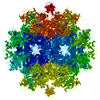
|
| 2 |
|
| 3 | x 5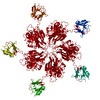
|
| 4 | x 6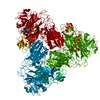
|
| 5 | 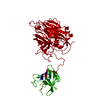
|
| Symmetry | Point symmetry: (Schoenflies symbol: I (icosahedral)) |
- Components
Components
| #1: Protein | Mass: 51303.062 Da / Num. of mol.: 1 / Mutation: P162S,N200S,A511S,L569I Source method: isolated from a genetically manipulated source Source: (gene. exp.)  Hepatitis E virus / Production host: Hepatitis E virus / Production host:  |
|---|---|
| Has protein modification | N |
-Experimental details
-Experiment
| Experiment | Method: ELECTRON MICROSCOPY |
|---|---|
| EM experiment | Aggregation state: PARTICLE / 3D reconstruction method: single particle reconstruction |
- Sample preparation
Sample preparation
| Component | Name: Hepatitis E virus / Type: VIRUS / Entity ID: all / Source: RECOMBINANT |
|---|---|
| Source (natural) | Organism:  Hepatitis E virus Hepatitis E virus |
| Source (recombinant) | Organism: |
| Details of virus | Empty: YES / Enveloped: NO / Isolate: OTHER / Type: VIRUS-LIKE PARTICLE |
| Buffer solution | pH: 7.4 |
| Specimen | Conc.: 2 mg/ml / Embedding applied: NO / Shadowing applied: NO / Staining applied: NO / Vitrification applied: YES |
| Vitrification | Instrument: FEI VITROBOT MARK IV / Cryogen name: ETHANE / Humidity: 100 % |
- Electron microscopy imaging
Electron microscopy imaging
| Experimental equipment |  Model: Tecnai F30 / Image courtesy: FEI Company |
|---|---|
| Microscopy | Model: FEI TECNAI F30 |
| Electron gun | Electron source:  FIELD EMISSION GUN / Accelerating voltage: 300 kV / Illumination mode: FLOOD BEAM FIELD EMISSION GUN / Accelerating voltage: 300 kV / Illumination mode: FLOOD BEAM |
| Electron lens | Mode: BRIGHT FIELD / Alignment procedure: COMA FREE |
| Specimen holder | Cryogen: NITROGEN Specimen holder model: GATAN 626 SINGLE TILT LIQUID NITROGEN CRYO TRANSFER HOLDER |
| Image recording | Electron dose: 25 e/Å2 / Detector mode: INTEGRATING / Film or detector model: FEI FALCON II (4k x 4k) |
- Processing
Processing
| Software | Name: PHENIX / Version: 1.11.1_2575: / Classification: refinement | ||||||||||||||||||||||||
|---|---|---|---|---|---|---|---|---|---|---|---|---|---|---|---|---|---|---|---|---|---|---|---|---|---|
| EM software | Name: PHENIX / Category: model refinement | ||||||||||||||||||||||||
| CTF correction | Type: PHASE FLIPPING AND AMPLITUDE CORRECTION | ||||||||||||||||||||||||
| 3D reconstruction | Resolution: 3.4 Å / Resolution method: FSC 0.143 CUT-OFF / Num. of particles: 13759 / Symmetry type: POINT | ||||||||||||||||||||||||
| Refine LS restraints |
|
 Movie
Movie Controller
Controller



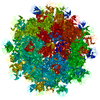
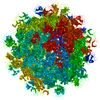
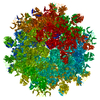

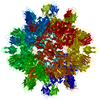
 PDBj
PDBj
